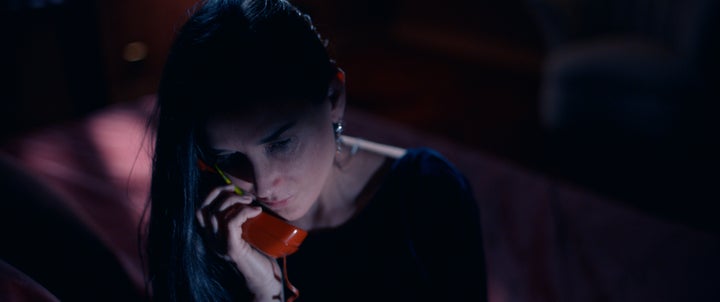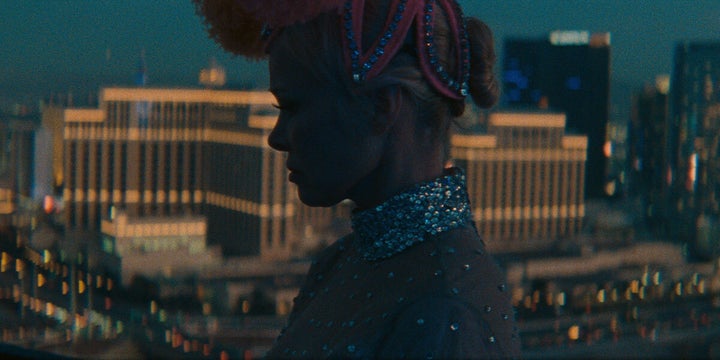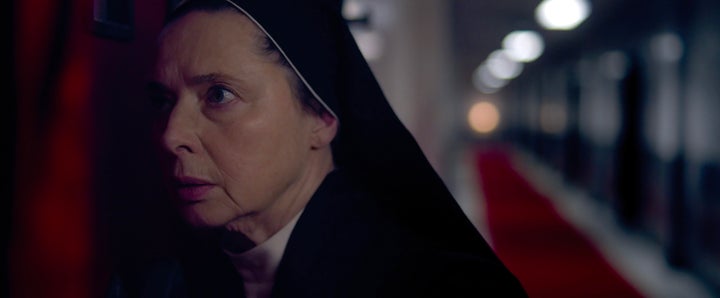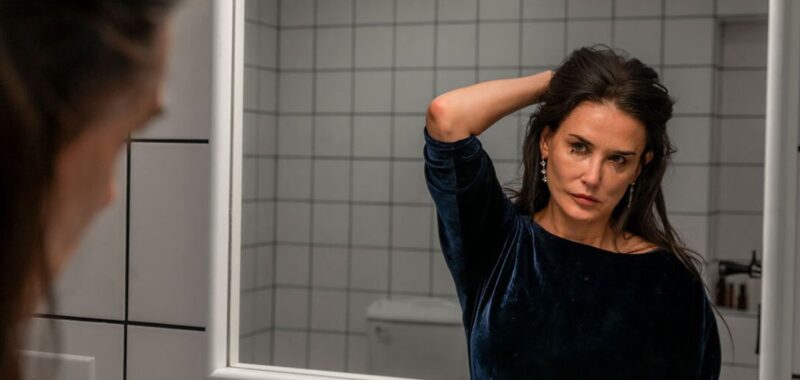TORONTO — It seems like every year an actor who fell out of the mainstream for a few years — or perhaps a decade or more — has an “-aissance.” Matthew McConnaughey had the McConaissance. Brendan Fraser received a warm welcome back to the spotlight with “The Whale.” John Travolta’s career reignited in the ’90s following the success of “Pulp Fiction.”
Each of those examples are white men who also earned Oscar recognition for their comebacks.
It’s different for female actors “of a certain age” (at the risk of repeating such a ridiculous phrase, because aren’t we all a certain age?). The women who were both beloved and admired for a fleeting time in Hollywood, before the industry — and undoubtedly some fans — turned their backs on them for the hotter, younger It Girl that came along.
Their however-much-lauded “return” is met with a bevy of both objectionable and compelling ruminations on age and perseverance as much as it presents genuinely opportunities to engage with the complexities of maturing humanity as depicted in their films. This year’s Toronto International Film Festival featured several offerings and revived leading ladies that do just that.
It kicked off with the “Demissance,” a nod to Demi Moore, 61, who is back on the marquee with a star-reanimating role as an Oscar winner turned workout video guru named Elisabeth Sparkle in writer-director Coralie Fargeat’s writhing and deliriously smart horror, “The Substance.”
Dropped by a team of even older (if you can believe it) white male network executives — led by an appropriately maddening one played by Dennis Quaid — for basically being what they consider over-the-hill and unbankable, a spiraling Elisabeth resorts to the titular street drug. It guarantees instant results to create a younger, consequently more thriving, version of herself.
The two versions of Elisabeth can’t precisely coexist. Actual age Elisabeth, dubbed “The Matrix,” has to be put in what is essentially a drug-induced coma brought on by delightfully cringey effects while her younger, conventionally attractive self (a sprightly and dutifully seductive Margaret Qualley) launches into superstardom.
It comes with some caveats. Such as, remember, both versions are one and there is no “me” and “her,” no matter how often one might think the other is driving her insane. But it wouldn’t be as good of a movie if caveats were ignored. Through progressively grotesque prosthetics and effects, Moore and Qualley effectively destroy each other on film for nearly 2½ hours.
With “The Substance,” Fargeat is keenly aware of the painfully honest truth that asks: How many women would pay attention to psychological side effects when faced with a new opportunity to live and thrive again in a place like Hollywood, where youth is the currency?

Who wants to be envied and have folks jerking off to your billboards instead of pitying you or, perhaps even worse, regarding you as a Yoda-like figure whose prior success acts as only a tool to guide a new generation — and not as a fully realized human who is sexual and has desires of her own?
Most of us are just not strong enough to say no, especially in today’s celebrity-obsessed culture.
“Hagsploitation” is how many described the film while on the ground at the Toronto International Film Festival (TIFF). The term refers to the decades-long trend of Hollywood genre films starring older female actors — think Bette Davis and Joan Crawford in 1962’s “What Ever Happened to Baby Jane?” for example — whose characters become increasingly unhinged. It’s always been a cheap word, one that entirely overlooks how the films are grappling with difficult truths women face as they continue to age — though, in a heightened sense, on par with the genre.
But “The Substance” is also a profoundly sad movie. It broods over the idea that youth could actually be an addiction that compels someone to take a mysterious drug to sustain it, disregarding the real issue of self-loathing that is only encouraged in a place like Hollywood.
In a no-holds-barred performance, Moore’s Elisabeth becomes a literal, physical embodiment of the freak that she was made to feel like. Moore is an esteemed actor, not unlike Elisabeth, who, throughout her 30s especially, engaged with the male gaze in films like 1993’s “Indecent Proposal” and made headlines when she posed nude and pregnant on the cover of Vanity Fair in 1991. Then, in recent years, Moore became the subject of cruder news stories that speculated about her having plastic surgery.
The industry is overly preoccupied with youth — yet somehow cannot fathom why anyone could even consider altering themselves to comply with the standard. So older female actors are tossed aside.
And yet, upon their return, she has to contend with questions about why she went away and what took her so long to get back. The answers should be clear to anyone who’s been paying even a little attention. It’s strange to experience a culture that appears to be both cognizant and ignorant of certain issues — particularly when it has exacerbated the problems itself.
We’re seeing the same thing with Pamela Anderson, 57, a woman who’s been easing her way back into the spotlight over the last few years, including in 2023’s buzzy though limp documentary on her life, “Pamela, With Love.”

Courtesy of Toronto International Film Festival
After reinventing the pinup fantasy for many horny, mostly white men in the ’90s, particularly as a hot lifeguard on the series “Baywatch,” Anderson aimed to ride that fame and be taken seriously as an actor in roles like 1996’s “Barb Wire.” Turns out, if she wasn’t bouncing along a beach in a bikini, few audiences or studios would pay her any mind.
As the years progressed, her escalating age and a string of other forgettable offerings, not unlike with Moore, didn’t help matters. Still, some may wonder how she ended up in director Gia Coppola’s intriguing drama, “The Last Showgirl,” at TIFF when it was only ever her affinity to arouse that kept her career soaring when it did.
Her role asks the same question. As solemn as “The Substance” is, but in a different way, “The Last Showgirl” follows Shelley, a showgirl in Vegas whose world is rattled when she learns that the show she’s been a part of since the ’80s is coming to a close.
Like “The Substance,” “The Last Showgirl” is in constant conversation with the idea of finality when a life is not otherwise over. With Shelley, we see a vitality in her interior life beyond the stage in the first half of the film. She has her showgirl group of friends — played by Brenda Song, Jamie Lee Curtis and Kiernan Shipka — who gather at her home for drinks and girl chat.
Shelley seems to have embraced her role as a maternal figure among her mostly younger colleagues, while the film also shows her maneuvering her costumes with far less ease than she probably once did, feathers and wing tips sometimes collapsing right off of her glittered body.
The audience gathers this only later in the film, through Shelley’s own enthusiastic recollections of how much she was the thing in the ’80s, with a poster of her on the cover of all the show’s marketing. But that sentiment never sounds like a boast. Rather, it seems to be a reflection of perhaps how tiny it all was ― and is in the grand scheme of things ― but all she’s ever had and wanted.
Several viewers in Toronto theorized that “The Last Showgirl” was another example of art imitating life, pointing to what they consider Anderson’s own yearning for a past life when her looks and youth were tethered to her success. But that seems like a hollow takeaway that doesn’t really connect with a perceived truth.
After “Baywatch,” Anderson seemed to be pursuing meatier opportunities that showcased her acting ability, and less so her physicality, but never really achieved those loftier goals. Shelley, like her friend, Annette (Curtis), actually desires being ogled on stage and bringing pleasure to audiences. It’s all she yearns for — and she cannot cope for the fact that that will never return.

It isn’t until her daughter, Hannah (Billie Lourd), reenters Shelley’s life that viewers actually understand that the mother’s perception of her life today is different from the reality. She’s been dancing in the back row of 80 other younger women on stage in front of a barely there audience.
Perhaps you can take that as a metaphor of Anderson’s own career, projecting aspirations on her to entertain as she once did, in a somewhat shallow way. But her performance as Shelley is still inspired and certainly unlike anything else she’s ever done.
Her kitten voice is still very much there as well as her signature blond, bouffant hair, now a bit more weathered. But there’s a confidence and ownership she brings to Shelley, including her sexuality, that seems different than before.
It’s a more internal performance, far less showy than Curtis’, whose brassy, tanorexic character dances by herself atop a poker table at the saloon where she now works and slowly dissolves into a puddle of her own nostalgia and irrelevance.
Curtis, 65, could be a whole case study of a mature female actor who has defied all of Hollywood age standards. She’s still in favor with fans across all generations and genres dating back to her Scream Queen status in 1979’s “Halloween” and has earned some of the most interesting roles of her whole career in recent years, including as Annette.

Courtesy of Focus Features
But she shouldn’t be considered an anomaly. Considering — or perhaps reconsidering, as we have been doing a lot lately — the space that women past the age of 50 occupy now in Hollywood, years after they were venerated, should begin with changing how we talk about them.
“What do we do with an icon?” is a question Isabella Rossellini, 72, recited in a recent interview with Variety, discussing her own role as a surreptitious nun in the towering TIFF drama “Conclave.” The actor recalls being asked that by an agency back when she had all but aged out of mainstream Hollywood.
It’s as if to say she is revered and has already accomplished everything she might ever attain — and during the time when she actually could. She’s renowned as both a Lancôme model and for numerous movies, including 1986’s “Blue Velvet” and 1992’s “Death Becomes Her.”
She’s also the daughter of the acclaimed actor Ingrid Bergman and director Roberto Rossellini, both of whom, she says, with noticeable sadness, are strangers to today’s generation: “It breaks my heart. Their reputations outlived them, but fame is very brief.”
Admittedly, it was only after she said that that it became clearer why Rossellini took offense at the “icon” remark. She even called it “ageist.” Because who doesn’t want to be an icon?
Maybe the term has lost some of its power in today’s generation, where everyone and everything is considered iconic if they do something cool one time. But that does cast a certain light on, particularly, the older women who were lauded for years before they were unceremoniously erased from conversation and limited in opportunities.
The better question, then, might be: How do we make room for an icon to evolve and flourish on screen — and bring forth authentic narratives that are satisfyingly complicated, sexual and/or frightening? Or maybe as a firm statement: Let’s make room for the icon. Period.
Support Free Journalism
Support HuffPost
Already contributed? Log in to hide these messages.
If the films at this year’s festival are any testament to the stories and perspectives we too often miss out on due to the deep-seated ageism, that should be a given.
“The Substance” will be released in theaters Sept. 20. “Conclave” will be in theaters Nov. 1. A U.S. release date for “The Last Showgirl” has not been announced.
Support Free Journalism
Support HuffPost
Already contributed? Log in to hide these messages.

